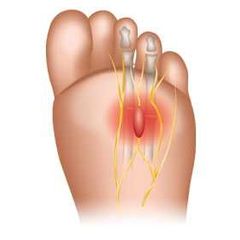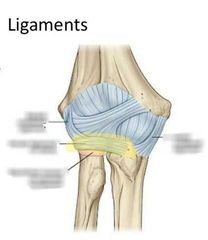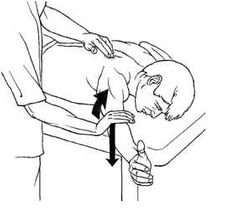![]()
![]()
![]()
Use LEFT and RIGHT arrow keys to navigate between flashcards;
Use UP and DOWN arrow keys to flip the card;
H to show hint;
A reads text to speech;
55 Cards in this Set
- Front
- Back
|
What motions are primarily limited in a patient with adhesive capsulitis? |
Lateral rotation, abduction Note: AC is more common in women than in men. |
|
|
What disease usually affects growing children/teenagers and is the result of repetitive traction on the tibial tuberosity? |
Osgood-Schlatter |
|
|
Condition that develops during the last trimester in utero that is often treated with a harness, bracing, splinting, or traction |
Congenital hip dysplasia |
|
|
Degeneration of the femoral head due to a loss of blood supply |
Legg-Calve-Perthes disease |
|
|
How can a sit-up be modified for those with weak abdominal muscles? |
Place a wedge behind head and shoulders |
|
|
What might cause a scaphoid fracture and how does the injury present? |
FOOSH; With localized pain in the anatomic snuff box |
|
|
What are ways to boost patient compliance when giving a HEP? |
1. Select exercises consistent with rehab goals 2. Keep the program short (10-15 min.) 3. Select only 5-7 different exercises
|
|
|
During the Neer impingement test, the supraspinatus tendon can become trapped between which two structures? |
Greater tubercle of humerus and anterior acromion |
|
|
What ligament on the lateral side of the ankle is most often injured? |
Anterior talofibular ligament |
|
|
During ambulation on a level surface, a patient requires ____° of hip flexion, ____° of knee flexion, and ____° of plantar flexion. |
30, 60, 20 |
|
|
Which gender and age of person will likely demonstrate the greatest amount of anteversion? |
Females (2x as likely as males) Child or adolescent Note: normal angle is 8-15° |
|
|
How do patients with a transfemoral amputation create knee extension of the prosthesis?
|
Through active hip extension |
|
|
A PTA assesses the LE muscle length of a 26-year-old male with LBP. What is the MOST appropriate method to test the length of the patient's left iliopsoas?
|
Thomas test - pt. lying in supine with R hip flexed to the chest and L leg extended |
|
|
What is the extension progression for a patient with disk protrusion? |
1. Prone w/ pillow under waist 2. Prone 3. Prone on elbows 4. Prone press-up 5. Standing extension |
|

Pain in this area is associated with what condition? |
Morton's neuroma This is a benign neuroma commonly affecting the 3rd interdigital nerve between the 3rd and 4th metatarsal heads. |
|
|
Where do ganglion cysts most commonly occur? |
On the dorsum of the hand at the wrist or on the dorsum of the foot.
|
|
|
Which motions combine to create pronation in a non-weight bearing foot?
|
Abduction, dorsiflexion, eversion
|
|
|
Which area of the therapist’s body would be most appropriate to utilize when assessing the patient’s skin temperature?
|
Dorsum of the hand
|
|
|
When will a tendon be most prominent and easily palpated? |
A tendon becomes most prominent when the associated muscle is active.
|
|
|
What is the angle formed in the frontal plane between the humerus and ulna?
|
Carrying angle Note: Normal is 5-10° for males and 10-15° for females. |
|

|
Annular ligament (wraps around the head of the radius and secures it to the ulna) |
|
|
Grip strength measurements are typically measured in kilograms of force. What are the average grip strengths for males and females?
|
Males: 106-112 Females: 61-64 |
|
|
To minimize muscle guarding, a passive stretch should utilize ____ tension applied over a ____ period. |
moderate; prolonged |
|
|
What is a standard method to assess the strength of the lower abdominal muscles?
|
Patient is positioned in supine with the hips flexed to 90 degrees and the knees extended. As the patient slowly lowers her extended legs toward the horizontal, observe for increased lordosis.
|
|
|
What are the prosthetic causes of excessive knee flexion during stance? |
- Socket set too far forward in relation to foot - Excessive DF - Stiff heel - Prosthesis too long |
|
|
What are the prosthetic causes of a circumducted gait? |
- Prosthesis too long - Excessive knee friction - Socket too small - Excessive PF |
|
|
What are the prosthetic causes of lateral bending? |
- Prosthesis too short - Improperly shaped lateral wall - High medial wall - Prosthesis aligned in abduction |
|
|
What is the average amount of time spent in stance phase during the gait cycle? |
60% |
|
|
Which muscle would likely possess the most sustained activity throughout the swing phase of gait?
|
Tibialis anterior (dorsiflexor) |
|

This position is used to test which muscle? |
Lower trapezius |
|
|
In what position should the head be to effectively stretch the L upper trap? |
In R lateral flexion and L rotation with L shoulder depression |
|
|
What are some words a patient might use to describe a musculoskeletal pattern of pain?
|
Aching,heavy, cramping, sore, etc. |
|
|
What is torticollis and what is it characterized by? |
Torticollis is shortening of the sternocleidomastoid muscle. This condition is characterized by ipsilateral lateral flexion and rotation toward the contralateral side. |
|
|
What are some of the joints most commonly affected by osteoarthritis? |
The hands and weight bearing joints such as the hips and knees.
|
|
|
A condition where breakdown of striated muscle fibers leads to the release of myoglobin into the bloodstream
|
Rhabdomyolysis |
|
|
How is rheumatoid arthritis diagnosed? |
Clinical presentation of involved joints Presence of blood rheumatoid factor Radiographic changes (Blood tests are the most definitive.) |
|
|
What passes through the thoracic outlet? |
Brachial plexus trunks Subclavian vein Subclavian (axillary) artery |
|
|
Condition where one vertebra slips forward on the one below it due to a bilateral fracture of the pars interarticularis; usually occurs at L4/L5 or L5/S1 |
Spondylolisthesis; children ages 10-15 who are involved in activities such as gymnastics, weight lifting, volleyball, and pole vaulting are particularly susceptible. |
|
|
Systemic condition that is characterized by inflammation of the spine and larger peripheral joints, causing destruction of the ligamentous-osseous junction and leading to fibrosis and ossification |
Ankylosing spondylitis |
|
|
While performing core strengthening exercises, the spine must be maintained in a ____ position. |
Neutral |
|
|
Tightness of which muscle might cause a crouched gait in someone with spastic diplegia? |
Iliopsoas (The iliopsoas tendon can be released surgically in order to decrease crouching.) |
|
|
During which test is the patient positioned in prone with the knee flexed to 90 degrees while the PTA palpates the greater trochanter? |
Craig's test for anteversion |
|
|
In which test is the patient positioned in prone while the PTA flexes the patient's knee and watches for spontaneous hip flexion? |
Ely's test for rectus femoris contracture |
|
|
What are the pressure tolerant areas on a transtibial residual limb? |
Patellar ligament Lateral fibular shaft Medial and lateral tibial shaft |
|
|
What are the pressure sensitive areas on a transtibial residual limb? |
Fibular head Lateral tibial flare Tibial crest Distal ends of tibia and fibula Patella Tibial tuberosity Adductor tubercle Peroneal (fibular) nerve |
|
|
What are the pressure tolerant areas on a transfemoral residual limb? |
Ischium Soft tissue of the limb |
|
|
What are the pressure sensitive areas on a transfemoral residual limb? |
Greater trochanter Pubic tubercle, ramus, and symphysis Distal end of femur Perineum |
|
|
What is step length? |
Distance between R heel strike and L heel strike |
|
|
What is stride length? |
Distance between R heel strike and following R heel strike |
|
|
Number of steps an individual will walk over a period of time is called what? |
Cadence Note: Average adult cadence is 110-120 steps per min. |
|
|
What are three conditions that could cause a toed-in gait? |
Femoral anteversion Internal tibial torsion Metatarsus adductus |
|
|
What muscles are used to perform a seated rowing exercise? |
Trapezius Rhomboids Posterior deltoid Latissimus dorsi Teres major |
|
|
Which muscle group is working to control knee flexion/extension while descending stairs? |
Quadriceps are working eccentrically |
|
|
A patient with a transfemoral amputation would be most likely to develop contractures in which muscle groups? |
Hip flexors, abductors, and ERs |
|
|
Shortening of which muscle could cause a patient to increase lumbar lordosis in order to achieve greater shoulder flexion when in supine? |
Latissimus dorsi |

